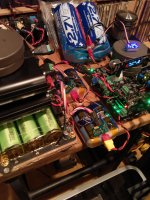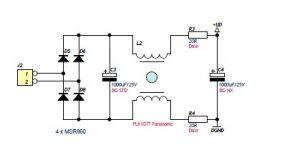@ozcal,
Sorry, I missed your request. I detailed the mods I did to the Shanti's I have here in post #335 of this thread:
Shanti Dual LPS 5V/3A , 5V/1.5A
Remember, these are likely warranty-breaking mods!
Greg in Mississippi
Sorry, I missed your request. I detailed the mods I did to the Shanti's I have here in post #335 of this thread:
Shanti Dual LPS 5V/3A , 5V/1.5A
Remember, these are likely warranty-breaking mods!
Greg in Mississippi
@jimk04,
First, @Randytsuch's post above is a wealth of good info! Listen to his counsel!
See this thread for info on Ian's UCPi boards which he used and offered when he was first playing with UCs:
Ian's Ultracapacitor Explore PLUS - build thread
The first post links to the post with many of the details in the relevant thread. In post #34 I detail how I've set mine up and use them.
You can also see some comments I made on the sonics with them with different power schemes (and with an older UC model that I ultimately stopped using because I could hear an upper-mid/lower-treble emphasis with them in the circuit) in post #126 of this thread:
Getting the best out of Allo.com's new Katana DAC...
The more recent 350F or 325F Maxwell parts do not have that emphasis to my ears.
I pre-charge my UC pairs to 3.3V (for Ian's GB boards) or 5V (for Allo Katana DAC and Microprocessor boards along with their USBBridge Signature) and connect them once precharged. Having an individual voltage monitor on each pair when charging and before connecting is a crucial safety element IMHO.
Note that I'm now using 3000F UC pairs to power my USBBridge Signatures. THEY ARE MONSTERS! I'm not sure if I'll end up preferring them solo or with a pair of either 350F or 325F Maxwells in parallel, but I doubt I'll be taking them out!
Greg in Mississippi
First, @Randytsuch's post above is a wealth of good info! Listen to his counsel!
See this thread for info on Ian's UCPi boards which he used and offered when he was first playing with UCs:
Ian's Ultracapacitor Explore PLUS - build thread
The first post links to the post with many of the details in the relevant thread. In post #34 I detail how I've set mine up and use them.
You can also see some comments I made on the sonics with them with different power schemes (and with an older UC model that I ultimately stopped using because I could hear an upper-mid/lower-treble emphasis with them in the circuit) in post #126 of this thread:
Getting the best out of Allo.com's new Katana DAC...
The more recent 350F or 325F Maxwell parts do not have that emphasis to my ears.
I pre-charge my UC pairs to 3.3V (for Ian's GB boards) or 5V (for Allo Katana DAC and Microprocessor boards along with their USBBridge Signature) and connect them once precharged. Having an individual voltage monitor on each pair when charging and before connecting is a crucial safety element IMHO.
Note that I'm now using 3000F UC pairs to power my USBBridge Signatures. THEY ARE MONSTERS! I'm not sure if I'll end up preferring them solo or with a pair of either 350F or 325F Maxwells in parallel, but I doubt I'll be taking them out!
Greg in Mississippi
Attachments
I soldered the NDK clocks onto the adaptors this weekend ...or maybe I ought to say I tried.!
Fitted them onto the Fifo but I get the never ending dots on turn controller display, and when I stream music I see the toggling leds on there somewhere.
I guess my soldering hasnt been successful.?!
Fitted them onto the Fifo but I get the never ending dots on turn controller display, and when I stream music I see the toggling leds on there somewhere.
I guess my soldering hasnt been successful.?!
Where did you add jumpers?
Hey Randy, Sorry I missed your message. It seems like you have it all sorted though!
I thought I would put a quick update in. I have tidied up my set-up and let it settle.
I have a round of implementation improvements planned and waiting on some interesting upcoming hardware from Ian and Andrea to release before I box it.
However, I have been messing around with clocks.. I have tried three difference NDK clocks of the same family, to listen to how big the differences are between clocks. I have no way to measure them and was purely subjective listening. I couldn't tell much difference.
I then bought an accusilicon clock (45mhz) in December, whilst waiting for more clock boards from Ian's GB. This was a significant jump over the NDK's on a soic adapter and Ian's NDK boards which arrived later.
I thought Accusilicon was a budget clock, but I was wrong. Much more natural tone, more depth etc etc.
Worthwhile investment.
I am getting my Fifopi soon.
To supply a clean 3.3V clean power, does it mean I should set a dedicated secondary trafo winding, rectification & filtering and regulator just for Fifopi's 3.3V?
Can I draw from 5V RPi power via a 3.3V Lt3045 regulator?
Feeding fifopi with 3.3v only has advantages if you do it from a battery supply (preferably with ultracaps) and bypass the on-board regulators.
If you are feeding your fifopi with an LT3045 regulated ps you can better just feed 5v and keep the local regulators in place.
Feeding from the same ps as the rpi is not reccommended, the ps line on an rpi is not clean, in this way the isolator part of the fifopi will be useless.
Great! I will follow your advice. Thanks.
Feeding fifopi with 3.3v only has advantages if you do it from a battery supply (preferably with ultracaps) and bypass the on-board regulators.
If you are feeding your fifopi with an LT3045 regulated ps you can better just feed 5v and keep the local regulators in place.
Feeding from the same ps as the rpi is not reccommended, the ps line on an rpi is not clean, in this way the isolator part of the fifopi will be useless.
Re 5v supercap supply for Rpi
I have seen much discussion re pre charging supercaps. FWIW I will share my simple approach. I use 50F caps on the 5v supply to the Rpi. So much smaller than some I see here, but still a serious pair of caps. The PS is a simple linear CRC filtered linear supply regulated with the high amp version of the 7805. I put a heat sync on the 7805 consisting of a simple strip of brass. No problem with heat dissipation and no pre-charging required. Just flip the switch and it charges up in a few seconds and runs for weeks/months without issue. Great sound.
I have seen much discussion re pre charging supercaps. FWIW I will share my simple approach. I use 50F caps on the 5v supply to the Rpi. So much smaller than some I see here, but still a serious pair of caps. The PS is a simple linear CRC filtered linear supply regulated with the high amp version of the 7805. I put a heat sync on the 7805 consisting of a simple strip of brass. No problem with heat dissipation and no pre-charging required. Just flip the switch and it charges up in a few seconds and runs for weeks/months without issue. Great sound.
I have seen much discussion re pre charging supercaps. FWIW I will share my simple approach. I use 50F caps on the 5v supply to the Rpi. So much smaller than some I see here, but still a serious pair of caps. The PS is a simple linear CRC filtered linear supply regulated with the high amp version of the 7805. I put a heat sync on the 7805 consisting of a simple strip of brass. No problem with heat dissipation and no pre-charging required. Just flip the switch and it charges up in a few seconds and runs for weeks/months without issue. Great sound.
A picture of this setup would be highly appreciated
How does one know you are listening to that supercap and not the 7805 in this case?
Add a switch so you can disconnect the 7805 and decide if it makes a difference. But the caps need to be large enough to power your setup without help.
I like the quote... "everything counts". In this case it means you are listening to the 7805, the supercaps, the transformer, the diodes and the filtering caps. It is a good linear PS with a LM7805 and supercaps powering a computer. Beats a switching PS by a long shot, but certainly not perfect. Quite sufficient for the task. In an earlier life it powered a DAC that was well regarded on these forums and now it powers a computer. It is enough for me.How does one know you are listening to that supercap and not the 7805 in this case?
PS schematic below. Caps are now Panasonic. Smaller resistors. LM7805 follows, then 2x 50F supercaps feeding the Rpi.
Attachments
Last edited:
I use Nesscap ESHSR. 14mOhm.Good information thankyou. Can I ask what 50F caps you use?
ESHSR-0050C0-002R7 NessCap Co Ltd | Capacitors | DigiKey
Nesscap was one of the early innovators. I believe ultimately acquired by Maxwell. I worked for a tech startup that used millions of these in the PS for industrial wireless communications modules. So I had a bunch of these in my parts bin that have now found new life in my streamer. They are still available at Digikey. You will find the same thing with a Maxwell label as well.
So you simply parallel supercaps at the regulator’s output?
No special circuitry to control the caps?
2.7V supercaps for use at the RPi’s GPIO 5V pin?
I thought it will blow with lower than 5V voltage cap.
I did a similar thing with Two 2200uF/10V cape at the GPIO pin 4 and ground before; the improvement is quite noticeable. Harshness is greatly reduced and bass is more defined.
I really want to try supercaps if connection is simple.
No special circuitry to control the caps?
2.7V supercaps for use at the RPi’s GPIO 5V pin?
I thought it will blow with lower than 5V voltage cap.
I did a similar thing with Two 2200uF/10V cape at the GPIO pin 4 and ground before; the improvement is quite noticeable. Harshness is greatly reduced and bass is more defined.
I really want to try supercaps if connection is simple.
2.7V supercaps for use at the RPi’s GPIO 5V pin?
I thought it will blow with lower than 5V voltage cap.
Ultracapacitor Example No1
A 5.5 volt, 1.5 farad ultracapacitor is required as an energy storage backup device for an electronic circuit. If the ultracapacitor is to be made from individual 2.75v, 0.5F cells, calculate the number of cells required and the layout of the array.
ultracapacitor voltage
The array will therefore have two capacitor cells of 2.75v each connected in series to provide the required 5.5v.
https://www.electronics-tutorials.ws/capacitor/ultracapacitors.html
2x 2.7V capacitors connected to each other in series then placed in parallel across the supply.
Series connected yielding a 5.4v 25F cap. No additional circuitry. If you go beyond 2 series caps use balancing resistors to ensure even distribution across the caps.So you simply parallel supercaps at the regulator’s output?
No special circuitry to control the caps?
2.7V supercaps for use at the RPi’s GPIO 5V pin?
- Home
- Source & Line
- PC Based
- IanCanada's Latest RPi GB Goodies Impressions... and your tweaks, mods and hints...

